Every year, OPB tries to ask the students in its Class of 2025 project the same question:
“What do you want to be when you grow up?”
Over the years, some answers have changed. Others have stayed the same. Some of the same students who said “I don’t know” in 1st grade are still figuring it out now, as juniors in high school.
Now the Class of 2025 is less than two years away from high school graduation, the future is becoming real, and students are actively figuring out what they want to do after high school. For some students, that means getting a first job. But in schools around the country, you can explore potential careers without leaving your high school.
There are many reasons students take career technical education classes: For fun, for a more hands-on learning experience, or to try out potential careers. As juniors at Southeast Portland’s David Douglas High School, some students in the Class of 2025 have flexibility in their schedules to add as many CTE classes as they have room for. They also can dive deeper into programs that may earn them college credit before leaving high school.
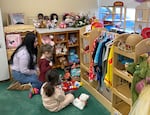
Students in David Douglas’ preschool play with one of the high school students in the early childhood education career technical education program. Students in the program get experience teaching and working with preschool students as part of a class.
Elizabeth Miller / OPB
In addition to college credit, CTE classes help students build real-life skills and guide plans for the future.
At the same time, these classes can yield powerful results when it comes to graduation rates and life after high school.
Students who participate in career tech classes tend to have higher graduation rates than students who don’t. In Oregon, students in the Class of 2022 who earned at least two credits in a CTE program had a 93% graduation rate, compared to 81% statewide. That’s the case for David Douglas too, where the graduation rate for these CTE concentrators was 93.6% compared to the overall high school rate of 78.3%. As for after high school, a 2020 study found Oregon students who completed a CTE program in high school had higher annual earnings than students who did not.
Endless possibilities at Oregon’s largest high school
At one end of the sprawling campus of David Douglas High School — the largest public school in the state — the south building is home to a large commercial kitchen and fully operational restaurant, The Kilt Eatery. There’s a preschool at the other end of the building with name cards for each student at two big round tables.
Both programs are staffed by David Douglas students, connecting them to early education and the hospitality industry while also providing them with transferable skills like organization and working in a team.
On a recent November morning, Class of 2025 student Kaylie was one of several students in the preschool room, waiting for the young children to arrive. One by one, the children showed up, and two high school “buddies” greeted them at the doorway, walking them in and getting them situated.
“I like your jacket, that’s so cute!” Kaylie said to her buddy before they joined another high school student at a table to work on the day’s art project, watercolor painting.
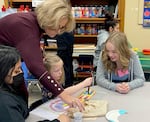
Class of 2025 student Kaylie, right, plays with Paige, a preschooler, center, at David Douglas High School. Kaylie is part of a career technical education program focused on early childhood education, which involves planning lessons for a preschool class.
Elizabeth Miller / OPB
Later, the high school students go to different activity stations across the classroom, as preschoolers choose whether they want to paint at an easel, organize translucent objects at the light table, or read in the library.
After a few different rounds going from activity to activity, the preschoolers find places to sit on the carpet for a lesson on nursery rhymes taught by Kaylie and two classmates. The high schoolers will be graded on the group lesson, including the art project from the beginning of class.
After the lesson, the preschoolers and the high school students head outside for a chilly recess. Reflecting on the lesson, Kaylie said it went well.
Kaylie had a number of absences this fall and was unable to help out with a lot of the lesson planning as a result. She helped create the big poster and plan for the art project — which she said may have been a little confusing for the kids.
“But besides that I think it was really fun,” she said, “I think they enjoyed it a lot.”
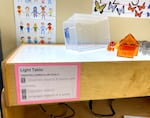
During the day, the young students attending preschool at David Douglas can play at different activity stations around the classroom, all with different curriculum goals.
Elizabeth Miller / OPB
Last time OPB asked Kaylie what she wanted to be when she grew up, this past summer, she expressed interest in teaching.
“I think it would be fun, especially teaching either high school or little kids,” she said at the time.
The class she’s taking this year offers a chance to try it out.
“I really like just interacting with the kids,” she said. “Knowing that I’m going to be a part of their memories and development, it’s really cool.”
David Douglas offers 11 CTE programs ranging from education and culinary arts to health sciences and construction, with some of them offering college credit. The school’s CTE program is likely to expand in the future thanks to a bond voters passed in 2022 that will create a “Future Careers Center” on campus.
Some students, like those in the high school’s culinary arts program, can earn college credit and certifications that will help them outside of school. Students need a food handler’s card to work in the kitchen, where they prepare a full meal for 60 people weekly.
During a recent class period, students in the Culinary Arts 1 and 2 classes prepped for their Thursday meal service at The Kilt Eatery. Two students came up with the menu: carne asada, Mexican rice, and tres leches cake. Students were in constant movement — mixing up the cake, boiling water for the rice, prepping spice mixes, washing dishes, and changing the playlist of songs reverberating through the restaurant.
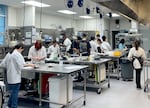
Students in Whitney Harvey’s culinary classes prepare a meal for The Kilt Eatery, the school’s restaurant. The restaurant is part of the school’s culinary arts CTE program, where students can learn skills from cooking to collaboration.
Elizabeth Miller / OPB
Students have to take several classes to get here — starting with two Food Sciences classes in a more typical classroom setting, where students learn the basics of cooking. From there, students take Intro to Restaurants and Culinary Arts 1 and 2, where they start working in the commercial kitchen, serving students and staff at the restaurant and earning college credit awarded by Central Oregon Community College.
Whitney Harvey and Janet Costello-Plummer are culinary arts teachers at David Douglas.
“We try to give them every single experience we possibly can within a restaurant,” Harvey said, “so that they’re prepared — they understand different aspects of that restaurant.”
Students learn how to do different jobs in a restaurant, but also how to put together a menu. Harvey said some students go through the program because the food industry is what they want to do after high school.
“Some of them, they just really love to cook and they just want to be a part of that as long as they can before they move on to something else,” Harvey said.
Trying out different careers — without the risk
In 2019, David Douglas created the Linda Vancil CTE Excellence Award, named for an outgoing assistant principal who oversaw the school’s CTE programs. The award goes to the student who completes the most CTE programs, defined as earning two or more credits in a specific CTE program.
The most recent Linda Vancil award winner completed four different programs; automotive, construction, computer information systems, and engineering.
“Kids have a lot of opportunities to explore different career pathways without any of the risk that goes with that — they can check it out in high school, figure out, ‘oh, this is for me or not for me’ without having to spend their time, their finances, getting degrees that might not benefit them,” Harvey said.
But it wasn’t always this way.
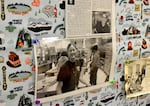
Teachers Janet Costello-Plummer and teacher Whitney Harvey in a printed article on a bulletin board in The Kilt Eatery dining room. Costello-Plummer is one of several culinary arts teachers at David Douglas High School, in a program where students can earn college credit and work in a restaurant at the school.
Elizabeth Miller / OPB
Harvey and Costello-Plummer are both graduates of David Douglas High School, classes of 2005 and 2003, respectively. Currently, Oregon students need to have three credits of either career and technical education, arts, or world languages to graduate from high school. Beginning with the Class of 2027, students are required to also have a half credit in “higher education and career path skills,” which means they’ve received instruction on how to apply for jobs, or developed career-related skills.
But when Harvey and Costello-Plummer were students, a different career-related graduation standard was in place: the certificates of mastery. A Certificate of Initial Mastery required students to show proficiency in English, science, and math “through test scores and work samples.” A Certificate of Advanced Mastery would be awarded to students who “participated in career-related learning experiences.” But state legislators abolished the CIM and CAM in 2007.
Harvey, who knew she wanted to be a teacher, took social human services, “where you could be a teacher or an FBI agent,” Harvey said, jokingly.
She recalled interning with a music teacher and a counselor, and submitting a portfolio in order to graduate.
“I still have my portfolio,” she said. “I found it this summer.”
She liked the program, but it felt too confining. She wished she could have participated in more programs, like culinary arts. The Kilt was open when she was a student. The flexibility DDHS has now when it comes to CTE wasn’t there before.
“I remember getting lunch from them sometimes, but I don’t remember being able to take the class because I wasn’t in the hospitality CAM,” Harvey said. She ended up going to college to be a social studies teacher.
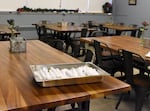
The dining room at The Kilt Eatery, where students and staff dine every Thursday, served by David Douglas High School students.
Elizabeth Miller / OPB
As a DDHS student, Costello-Plummer recalled going through the arts communication program.
“I did not know that I wanted to be a teacher in high school,” she said. In college, she started as an art major before switching to health education.
Before becoming two of David Douglas’ three culinary teachers, Costello-Plummer worked as a nutrition educator for the OSU extension program, visiting elementary, middle, and high school schools to cook with kids. Harvey worked as a substitute teacher.
“We didn’t actually go to school to be a family consumer science teacher because we didn’t know that was an option,” Harvey said.
Career classes offer students a break from desks — and real-world skills
In a typical school week, Class of 2025 student Austin might be making pizza dough in food science, building a stool in construction class, welding a toolbox in metals, or dissecting a Hostess Ding Dong in health sciences. It’s a break from the core requirements of chemistry, history, math and English.
“I just get to do things rather than sitting in a desk for the whole class. I actually get to move around and do things throughout it,” Austin said.
On a recent school day, he walks from Metals 2 to Health Sciences 1, where he can learn about different careers in the medical field. At the end of the last school year, Austin said he was interested in being a radiologist when he grew up. He’d heard about the job in a business class.
Now a junior, Austin is interested in nursing, which was sparked by his sister, who owns a care home.
“I would like to try and get into that field, and a lot of what you do in that is a lot of things that nurses do, so I’d like to go to school and learn about how to do those things better,” he said.
“It’s nice being able to help people, especially when they’re in a position where they can’t do things for themselves … oftentimes, they’ll be grateful for it, and it’s just a nice experience.”
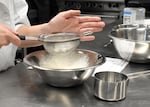
A student sifts flour for tres leches cake. Students in David Douglas High School’s culinary arts program create a menu weekly for The Kilt Eatery, a restaurant in the school that serves students and staff. Students had to make five cakes to feed 60 people.
Elizabeth Miller / OPB
The skills students learn in career classes can help with broader real-world skills. Kaylie, the 2025 student in childhood education, sees other benefits to working with preschoolers.
“I get to learn a little bit about what it’s like teaching a toddler for when I have kids,” she said. “Even if I’m not with them full time, I still get to see what makes kids upset and how to handle it.”
In the David Douglas High School culinary classes, students get to eat their work. But Harvey says there are lasting benefits, too.
“I always tell them, this is the best place to land because I know every single one of you are going to be cooking until your dying day, and it’s nice to know how to cook for yourself,” she said.
Beyond that, Harvey and Costello-Plummer hope students leave their culinary arts classes with “soft skills” like professionalism, working in groups, or putting together a big project — useful skills students can take with them, even if they don’t end up working in a restaurant.
“It’s all those forward planning steps that they get to experience and they can transfer that skill to any other job,” Costello-Plummer said.
Assistant principal Valoree Hill said programs also have a key benefit in offering students a place to belong in the state’s largest high school. Research shows that belonging matters for students. It can help them feel supported at school.
“It provides that sort of niche community to find that smaller space in a big community,” she said.
If you have questions or story ideas for the Class of 2025, reach out to Elizabeth Miller at emiller@opb.org.
